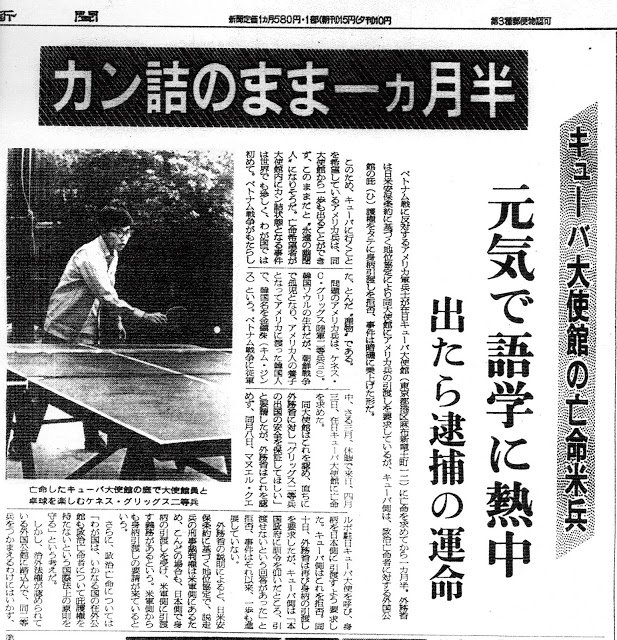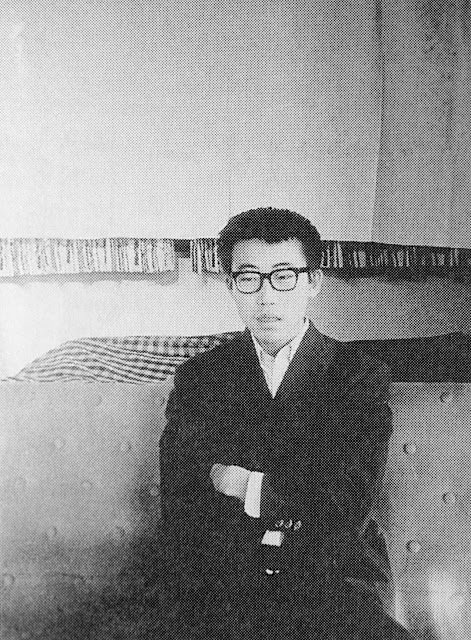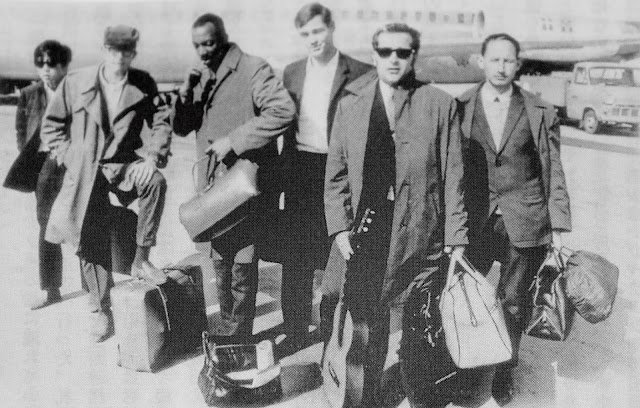32. Kim Jin-su’s Escape and Exile
Precursor to the Mỹ Lai Massacre: 1968 Phong Nhị, Phong Nhất_32: Kim Jin-su’s Escape and Exile
Click to read in Korean(망명객 혹은 '홈리스' 김진수)

〈Asahi Shimbun, which on May 17, 1967 reported the whereabouts of Kim Jin-su, who had been stuck in the Cuban embassy. The article was titled "A Month and a Half of Confinement," and showed a big photograph of Kim Jin-su playing table tennis with an embassy officials at the Cuban embassy's residence.
Kim Jin-su was homeless.[1]
On January 1, 1968, he opened his eyes after a quick nap on the sofa. The first light of the new year shone through the window of the tea house in Shinjuku, which was open 24 hours a day. He brushed his messy hair with his hands and went to the restroom to wash his face. It had been his fourth day wandering about without being able to find a place to lie down. He had to avoid all hotels that asked for some sort of identification, as it would be dangerous. He would inevitably have to come back to this tea house again tonight.
His action three days ago was reckless. He ended up pulling the trigger. On December 29, 1967, he sneaked out of his hiding place within the Cuban Embassy without any countermeasures. He was grateful to the embassy which had protected him for the last eight months. He visited Japan's largest labor activist group, the General Council of Trade Unions, but was unable to meet its officials. He had totally forgotten that it was the year-end holidays. He would have to wait a few days before people returned to work.
He came out of the tea house and mingled among the Japanese enjoying their holidays. During the day, he had to roam about the streets of Tokyo aimlessly and kill time. Somebody could have been following him. He looked around with a wary eye before heading to a restaurant to address his hunger. He was a lost fugitive whose home was neither Japan nor Korea. In fact, he had to cross a vast ocean to get to his homeland of America. With no legal way of getting back home, he stood in the labyrinth of darkness without light.
1. Friday the 11th, the morning issue of Asahi, Sankei and Yomiuri reported similar stories saying that Griggs fled the Cuban embassy on December 29th of last year.
2. The Foreign Ministry's political affairs bureau chief, Niiseki, said in a news conference on Tuesday afternoon that Griggs (Korean name Kim Jin-su), who was in political exile at the Cuban Embassy from April of last year, fled the embassy on December 29th of last year, and that the Foreign Ministry got this news from the Cuban Embassy in Japan on the same day. Meanwhile, the Foreign Ministry said it had summoned Cuban Ambassador Mendes to Japan on Tuesday and heard about how he might have escaped. It is not clear at this time whether or not the soldier fled voluntarily, but Mendes said he had prohibited the soldier from going out because there was a risk of arrest if he went outside the embassy.
3. Sankei said that Japanese security authorities believe that the soldier has already escaped from Japan and is in North Korea...
(The telegram that the Korean Ambassador to Japan sent to the Foreign Minister on January 11, 1968)
Kim Jin-su, American name, Kenneth C. Griggs, was a U.S. deserter from Vietnam. While working as a typist in the 191st Battalion of the U.S. Army in Saigon, he went on vacation to the U.S. Johnson Base in Saitama Prefecture, from where he went to the Cuban Embassy in Minato-ku, Tokyo, and sought asylum. It was on April 4, 1967. Cuba was an enemy state of the United States, where Fidel Castro (42), was speeding up the construction of the socialist country after overthrowing the pro-U.S. Batista regime in 1959.
Foreign missions enjoyed diplomatic privileges. The U.S. and Japanese governments asked the Cuban Embassy to extradite Kim Jin-su, but were unable to enter the embassy and arrest him. Kim Jin-su revealed his motive for defecting, saying, "I saw the U.S. invade Vietnam with my eyes and felt a deep hatred toward war." The Cuban government was determined to show utmost support for those who were seeking asylum from the empires of imperialism by allowing entrance into Cuba. However, unless the Japanese government allowed Kim to leave the country, there was actually no way for Cuba to take him in.
A couple days passed. Kim Jin-su spent time eating, sleeping and watching TV at the Cuban Embassy residence. He was also into studying Spanish and playing table tennis. After spending eight months like this, he escaped the Cuban Embassy without anybody realizing it, and commenced his homeless life. Maybe he had felt like a bird trapped in a birdcage at the Cuban Embassy residence. Or perhaps he had opted for adventure at the risk of being arrested.

The front page of the January 11, 1968 edition of the Asahi Shimbun, which reported that Kim Jin-su disappeared from the Cuban Embassy where he was in hiding.
When Kim Jin-su first applied for asylum in Cuba, the South Korean government was perplexed, as it had been reported that Kim Jin-su possessed a Korean passport. South Korea's diplomatic authorities were scrambling to find out Kim Jin-su's personal information and the current state of the incident. According to an investigation conducted by South Korea's foreign ministry, he had the following background:
Born in Seoul on December 25, 1946. Adopted by a Korea-based U.S. Army soldier from the 38th battalion on Nov. 23, 1956. Passports issued by the Korean government (number 9679). U.S. citizenship application denied in 1957. Became eligible for citizenship in 1961, but did not apply. Juvenile criminal police records searched in Idaho, USA. Enlisted in the U.S. Army in 1963.
This is the first case in which an active U.S. soldier with Korean nationality was dispatched to Vietnam but disappeared to the Cuban Embassy in Japan while on holiday and then disappeared again after eight months. The South Korean government was worried that Kim Jin-su would go to North Korea. Kim Jin-su could have become a trumpeter on the North Korean side at a time when South Korean troops were deployed to Vietnam and North Korea and South Korea were at the height of their confrontation.
Kim Jin-su's homeless roaming found rest on January 3. That night, he met with Yoshikawa Yuichi, a 37-year-old secretary general of Beheiren, Japan's largest anti-war peace group. On January 1, Kim knocked again on the door of the General Council of Trade Unions office. Omoto Yasuyuki, who used to work at the General Council of Trade Unions suggested they talk the next morning, and guided him to an inn run by a female owner he knew. And Omoto Yasuyuki thereafter introduced him to Yoshikawa Yuichi, the secretary-general of Beheiren.[2]
Yoshikawa Yuichi suggested that Kim Jin-su return to the Cuban Embassy. He believed that it wasn’t right for Kim to end relations like this after staying at the embassy residence for eight months. Yoshikawa Yuichi believed that Kim should also persuade and explain to the Cuban Embassy on his beliefs and intentions accurately and sincerely and come out after seeking understanding. That day, the two entered the Cuban Embassy secretly on a Cuban diplomat's vehicle. They deftly avoided the Japanese police's surveillance. The day he left the ambassador's residence again after consulting with the Cuban diplomatic authorities was January 7. He spent about 10 days at the home of Hotta Yoshie (46), a famous writer in Zushi, Kanagawa Prefecture, south of Tokyo. Even on the night of January 11, 1968, when South Korea's diplomatic authorities first learned of Kim's escape from the Cuban Embassy, Kim was at the home of Hotta Yoshie.
It may have been both a coincidence and fate that Kim managed to meet Beheiren officials, given that the very reason he decided to leave the military was due to Beheiren. He remembered a page from the propaganda leaflets he read in the streets of Ginza, Tokyo during his vacation in March of 1967. It was a four-page English-language version of "Japan's Letter to the U.S. Army Soldiers" handed out by Beheiren members. Kim was deeply moved by what the leaflet said about how Vietnam should be left to the hands of the Vietnamese, that its people should no longer be killed, and that soldiers should defect from the military." A few days later, Kim Jin-su became the first U.S. soldier to defect from a Japanese base by going to the Cuban Embassy via the Japanese Communist Party and the General Association of Korean Residents in Japan.

Kim Jin-su, during his time in Japan. Photograph provided by Hyun Soon-hye
It was a time when tens of thousands of Vietnamese objectors abounded in the U.S. mainland each year. Coincidentally, on April 4, 1967, the day Kim entered the Cuban Embassy, African-American human rights leader, Martin Luther King, Jr. made a stir around the world with his remarks against the Vietnam War. Fourteen days later on April 18, Muhammad Ali, a U.S. boxer who held the WBA champion title, refused to join the Vietnam War.
Kim Jin-su now had to leave Japan. Two months ago, in November 1967, Beheiren managed to help four U.S. soldiers, who defected from the aircraft carrier, Intrepid, escape via the Yokohama Route (Yokohama-Nahhodka-Stockholm). Thereafter, with the frequent emergence of U.S. deserters in Japan, they even created a private organization called JATEC in order to systematically aid those who wished to escape and seek asylum. Next was Kim Jin-su's turn. JATEC prepared a smuggle operation for Kim Jin-su who was hiding in Zushi, Kanagawa Prefecture, so that he could be transported safely to the houses of Beheiren members in Kobe, Kyoto and other areas.
1. According to the morning issue of Asahi Shimbun from Friday the 29th, Griggs (aka Kim Jin-su) who disappeared from the Cuban Embassy on December 29 last year, had already escaped to a third country with the help of a Japanese anti-war activist group.
2. Based on several sources of information, Griggs left the Cuban Embassy around December 29th of last year and contacted Japanese anti-war activists who then accepted his request and successfully helped him aboard a foreign ship between late December and early January, enabling him to escape to a third country. There was a lot of speculation that his final destination was either North Korea or Cuba, with the former being more likely.)
(On January 29, 1968, a telegram sent by Korea's ambassador to Japan to the foreign minister)
Asahi Shimbun was critically wrong. It was true that he received assistance from anti-war activists, but they made it seem as though he had already escaped to a third country. As a result, the diplomatic authorities of Japan and South Korea were also misinformed. In other words, Kim Jin-su had hidden himself well without being caught. The fact that he was at the Cuban Embassy once more also went undetected by U.S. and Japanese intelligence networks.
The misinformation on part of the Asahi Shimbun had its own grounds. This is because Kim Jin-su secretly boarded a Chinese ship in Kobe on January 19. He ended up getting off because of a communication error, and the voyage to China was canceled. His original plan was to travel to North Korea via China, led by a Japanese Communist Party group whose beliefs coincided with those of Mao Zedong's revolution. Cultural Revolution was at its height in China, yet behind the scenes, discussions on normalizing diplomatic relations with the U.S. were underway. It was not an appropriate time to welcome U.S. deserters.
Three months later, on April 22, 1968, Kim escaped to his third country. It was a new route that went through Nemuro, Hokkaido's easternmost area, to go to the Soviet Union by boat and then to Sweden by plane.[3] Before leaving, he raised a huge sum of 130,000 yen for Beheiren, which had offered him warmth and protection. It was his savings from a few years' salary. Kim also left a statement, calling it a 'message to the people of the United States, Japan and the world.'
"While living in the United States for 10 years, I wanted to be an American citizen. But I had to join the U.S. military and became a soldier, being dispatched to South Korea, Japan and finally Vietnam. First of all, I came to see the terrible reality of South Korea and at the same time began wondering how it came to be this way. Looking at war-struck Vietnam, I thought about what kind of future it would have to behold if the United States were to achieve its goals in Vietnam in the same way as it did on the Korean Peninsula.”

Kim Jin-su (far left) after arriving at Stockholm Airport in Sweden in late April 1968. To his right are Mark Shapiro, Terry Wittmore, Philip Calicott, Joseph Kmitz and Edwin Annette. Photograph provided by Hyun Soon-hye
Kim's escape journey was accompanied by five U.S. soldiers, including Mark Shapiro, Terry Wittmore, Philip Calicott, Joseph Kmets and Edwin Annette. All of them had sought help from Beheiren from February through March of 1968 after deserting their respective U.S. military bases in Japan. The moment the six finally got off at the Stockholm Airport is encapsulated in a photograph taken by the U.S. Associated Press. Kim Jin-su, the shortest one, is on the far left. He has his hands in his pockets, and through his sunglasses on could see his distant gaze. He often made cynical remarks on the idea of "state," but other than that, his words were few. He is neatly dressed in his jacket and dress shoes. There is also a soldier holding a guitar. It almost looks like a photograph of friends on vacation together. It was a sunny day at the end of April of 1968.
Kim Jin-su rejected his duty to return to Vietnam. Now, for the time being, he couldn't go back to the U.S. where his foster father was. He couldn't go back to Korea, where his blood-related family members were either. He couldn't come back to Japan. Freedom by means of escape was just another beginning of confinement. An exhausted shadow of fate reached its hand out to Kim Jin-su, an asylum seeker.[4]
[1] In writing this chapter, I referred to and quoted the following materials and works. "Ministry of Foreign Affairs: Defection of Kim Jin-su, a Korean-American, to Cuban Embassy in Japan, 1967-68" (preservation of diplomatic historical records), "How to imagine a defection within the `national border: Japan's anti-Vietnam War Movement and deserters" (Kwon Hyuk-tae, 2012), "Vietnam's 'anti-war state' U.S. military personnel and Japan's civil movement: War of the world," 2012
[2] This is the testimony of Sekiya Shigeru (1948~), a former JATEC activist who visited Korea at the invitation of the Institute for Korean Historical Studies in September 2014, which marked the 50th anniversary of the dispatch of troops to the Vietnam War.
[3] During the time of the Vietnam War, Sweden opposed the bombing of Northern Vietnam by the U.S. and was one of few countries that granted entry to U.S. army defectors and helped them seek asylum.
[4] Kim visited Japan in the late 1970s and early 1980s to meet the Beheiren people who helped him escape. There are testimonies that he visited Korea to find his birth parents and relatives to no avail. When asked about his whereabouts by his acquaintances, he allegedly responded that he now resides in Switzerland. If he is still alive, as of August 2019, he is 73 years old. I asked about him through the Swiss Korean Association and the Swedish Korean Society, but failed to get any meaningful information.
- Written by humank (Journalist; Seoul, Korea)
- Translated and revised as necessary by April Kim (Tokyo, Japan)
The numbers in parentheses indicate the respective ages of the people at the time in 1968.
Congratulations @humank! You have completed the following achievement on the Steem blockchain and have been rewarded with new badge(s) :
You can view your badges on your Steem Board and compare to others on the Steem Ranking
If you no longer want to receive notifications, reply to this comment with the word
STOPTo support your work, I also upvoted your post!
Vote for @Steemitboard as a witness to get one more award and increased upvotes!